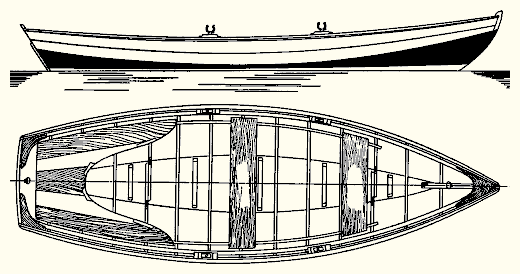

Any one knowing the sea-going capacity of a thoroughbred dory may feel very certain that if Ulysses in his seafaring wanderings subsequent to the Trojan War had sailed in a dory he would not have been wrecked on the shores of the mythical island of Oxgyia, nor, by the same token, been captured and kept for seven years by the beguiling sea nymph Calypso. The vessel in which that one-time king of Troy voyaged must have truly been a very inferior craft and its skipper somewhat soft in the matter of seamanship and moral deportment. For it is very pointed that neither he not his ancient ship in any respect equalled the salty wiles of the sea or the fragrant blandishments of the fair lady calling from the beach -- flirtatious Calypso.
There is planted somewhere in the form and model of a dory an old melody that captures the strings of desire not unlike the snatches of song that made of Ulysses a slave to Calypso. And all of us who have an appreciative eye for a boat of any kind fall for the wiles of this product of boat building men of the New England Coast. A dory is in itself a sea nymph; it is a type of boat that has excellent characteristics including ability to keep going in very rough water, handiness when on the beach or nested aboard a large vessel, simplicity of construction, light weight, easily propelled by oars, motor or sails, well behaved, and in its way desirable as a companion afloat as undoubtedly Calypso must have been ashore. At any rate the design for this month shows a capricious little boat and it seems most appropriate to give it a name which suggests capriciousness -- Calypso.

Our contribution this month shows complete designs of a rowing dory skiff. It retains the usual flat double-ended keel, or bottom, the lively sheer line and typical ends of most all boats of this particular type. The form and the construction are, one might say, standard practice for most all boats of this kind. And not unlike the past and present fleet of dories built up and down the coast of New England in many small shops by rule o' thumb experience; and those designed by distinguished yacht architects like Mower, Binny, Schock and others; and those modeled and built by Chaisson, Bachman, Lowell, Hammond, Gurney, Chamberlain, and others. All astonishing little boats -- and how many there are of them!
The plans of Calypso show a shipshape little hull 17 feet 2 inches in over all length; 14 feet on the water line; 5 feet 5 inches in breadth; and 5 3/4 inches in draft. The freeboard at the bow is 2 feet 1/4 inch, the least freeboard, 1 foot 2 5/8 inches, and the freeboard at the stem, 1 foot 6 1/2 inches. It will thus be seen that by any stretch of the imagination this is not a small boat. While the general form of the sides is rounding the sections both sides are formed by three straight (in an athwartship direction) planes. These are formed by the side of the keel, the two knuckles, and the edge of the deck, or sheer line; obviously an easy surface to plank.

The dory is primarily a rowing boat; but despite its beginning in oars the model is as much at home under the urge of a modest gasoline engine, or for that matter a center board and sails, as it is beneath the strong arms of an oarsman. For those that dislike muscular activities I would suggest the application of an outboard motor for this or some other dory.